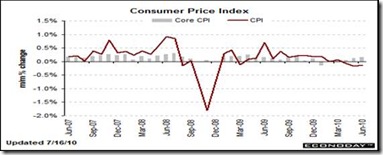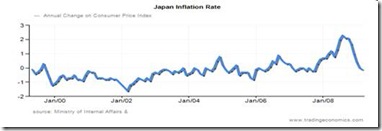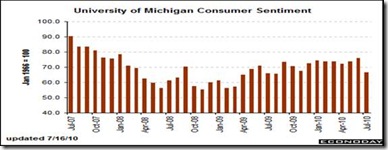Three new Federal Reserve Governors are up for confirmation that would fill out the Federal Reserve Board of Governors for the first time in years. And what are they saying? Surprise, surprise: “Fed Nominees Stress Job Creation,” was one of the headlines announcing their nomination by President Obama.
That is surprising because the Federal Reserve has since 1980 been fighting the specter (i.e, a ghost or phantom image, per Webster) of inflation. This is even though it has a twin mandate—promote growth (and jobs) while maintaining a stable currency (read low inflation rate). The two have come in conflict in the past, as when 1980 Fed Governor Paul Volcker raised the Fed Funds rate to 18.9 percent to dry out the double-digit inflation of the 1970s, causing two successive recessions (1981 and 1982).
And fighting inflation has had the upper hand ever since, which has resulted in the Fed raising interest rates at the drop of a hat, such as happened in 1994 that caused the Orange County bankruptcy, and job formation to suffer. The results are that job creation after the 1991 and 2001 recessions is the lowest on record.
Stanford economist Robert Hall, Chairman of the NBER business cycle dating committee, has attempted to explain why those two so-called modern recessions differed from the past, but comes up with no conclusive answer. “The facts are perplexing,” writes Hall in a recent Stanford paper, “employment falls at least as far as in past recessions, without identifiable driving forces.”
But Nobelist Paul Krugman has an answer in his blog. It is called demand-side (vs. supply-side) economic policies that have not been adequately utilized.
“One vision, which is the one I subscribe to, is basically an updated Keynesian view: sticky prices revised gradually based on unemployment and excess capacity, the possibility of persistent economic malfunction because people are trying to hoard cash rather than buying real goods. And this view also said that we were and are in a liquidity trap, in which things that might have been inflationary under other conditions — like a large expansion of the monetary base — weren’t at all inflationary under current conditions. In fact, the likely outlook was for falling inflation, and possibly deflation.
“The other vision was basically a crude quantity theory of money view: hey, the Fed is printing money, the government is running deficits, so high inflation, maybe even hyperinflation, is staring us in the face.”
“Sticky prices” refers to the theory that prices are slow to adjust downward during recessions. But that doesn’t mean that disinflationary, or even deflationary forces are not at work. And once they do begin to adjust downward in a sustained way, watch out. Profits and then wages are sure follow, resulting in a downward spiral of incomes and jobs.
“The past year has, in effect, been a fairly clean test of these two views,” says Krugman. “And what has happened has been very much what people like me said would happen: in the face of persistent high unemployment, inflation has fallen despite all that money creation, and interest rates have stayed low despite those budget deficits. If you bet on inflation and rising rates — which, by the way, Eric Cantor, the Republican House whip, did — you lost a lot of money.”
Yet in spite of this history, the Fed is still reluctant to add more stimulus to monetary policy. It has stopped buying mortgage backed securities (though interest rates are still at record lows) in a bid to boost real estate, and stated it is basically standing pat on monetary policy in its latest FOMC meeting.
Krugman thinks this is wrong-headed thinking. The latest Federal Reserve growth projections see core PCE inflation rising 1.2 to 1.6 percent through 2010, well within its stated target range of 1-2 percent. “I have no idea why Fed presidents expect core inflation to rise over the next two years,” he said. “Historically, high unemployment has been associated with falling, not rising inflation. In fact, my bet is that we will be near or into deflation by 2012. But even given the Fed’s own projections, it’s not doing its job, it’s missing its targets. Yet it apparently sees no need to act.”
Hence the Obama Federal Reserve appointees emphasis on job creation, rather than fighting inflation. The inflation numbers bear this out. We are approaching the danger zone of deflation, resulting in a vicious downward spiral of prices with stagnant growth, or stagdeflation, if you will.
Lower energy costs tugged down on the consumer price index in June, resulting in a third consecutive decline in the headline number. In June overall CPI inflation dipped 0.1 percent, following a 0.2 percent decline in May. The latest month matched the market projection for a 0.1 percent decline. Excluding food and energy, the CPI edged up to 0.2 percent after a 0.1 percent uptick in May.
Why the probability of deflation, when the economy seems to be recovering, with GDP growth positive over the last 3 quarters? The Japanese experience of deflation for 2 decades that set back their economic growth (and position in the world) is the best example. It portrayed the classic liquidity trap. No matter how much money was created by its central bank, investors and consumers refused to spend it. And so once the deflationary spiral downward began, it took decades to arrest. Their central bank did not react quickly enough to the bursting of both stock market and real estate bubbles that had reached record highs in 1990-01.
The problem by Japanese economist Richard Koo is that this is a ‘balance sheet’ recession. I.e., so much U.S. debt was piled up in the last decade with 2 wars and tax cuts to pay for, that both consumers and government must bring their balance sheets back into balance before what is called aggregate demand increases substantially.
The U. of Michigan had a record plunge in its sentiment survey, as if to emphasize the precariousness of consumers’ balance sheets. The economic recovery is slowing and consumer spirits are falling. Consumer sentiment literally plunged in the mid-July reading, down nearly 10 points to a 66.5 reading that pushes this index back to the lows of last year. Both the expectations and current-conditions components show roughly 10 point drops.
Even the minutes to the Federal Reserve’s last FOMC meeting emphasized the fragility of this recover. Fed officials noted that "the committee would need to consider whether further policy stimulus might become appropriate if the outlook were to worsen appreciably," according to the minutes. So emphasizing jobs formation is a must for the Fed’s monetary policy.
Harlan Green © 2010




No comments:
Post a Comment